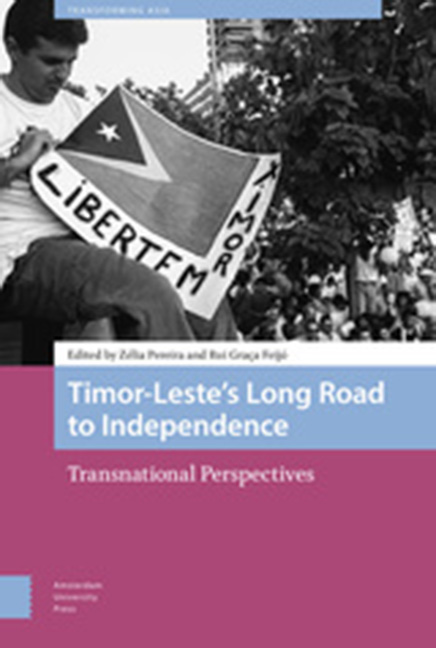Book contents
- Frontmatter
- Contents
- Acknowledgements
- A Note on the Name of the Country
- List of Figures
- Introduction: Timor-Leste’s Long Road to Independence: Outline for an Analytical Framework
- Part One Before The Portuguese Decolonisation
- Part Two The Portuguese Revolution Arrives In Timor-Leste
- Part Three Reaction To The Indonesian Invasion Of Timor-Leste
- Part Four Resisting The Indonesian Annexation Of Timor-Leste
- Index
11 - “I Follow the Screaming”: The Timorese Catholic Church and the Struggle for Independence
Published online by Cambridge University Press: 14 February 2024
- Frontmatter
- Contents
- Acknowledgements
- A Note on the Name of the Country
- List of Figures
- Introduction: Timor-Leste’s Long Road to Independence: Outline for an Analytical Framework
- Part One Before The Portuguese Decolonisation
- Part Two The Portuguese Revolution Arrives In Timor-Leste
- Part Three Reaction To The Indonesian Invasion Of Timor-Leste
- Part Four Resisting The Indonesian Annexation Of Timor-Leste
- Index
Summary
Abstract
This chapter presents the role of the Catholic Church in the process of Timor-Leste securing its independence between the Indonesian invasion in 1975 and the self-determination referendum in 1999. It focuses on why the Church played such an important role and explains how the Church used its extensive network throughout the world to denounce human rights violations in Timor-Leste. It also reveals its cooperation with the Resistance. At the same time, the Church achieved a strong religious identification among the people of Timor-Leste to Catholicism. The massive conversion to Catholicism became a political act because the Church had become so identified with, and a critical part of, the resistance to Indonesia's domination but also because it provided the protection much needed among the Timorese.
Keywords: Catholic Church, resistance, religious personnel, Vatican, NGO
On December 7, 1975, troops from the Republic of Indonesia initiate a formal invasion of Timor-Leste. Thousands of paratroopers descend over Dili, and dozens of landing barges attack its shores. The carnage is immense. At the bishop's residence, D. José Joaquim Ribeiro and his vicar-general, Martinho da Costa Lopes, are alerted to the ongoing massacre. Later on, the latter would recall that day:
Many paratroopers descended from heaven. As they were falling down, pop … pop … pop …. Many were fired upon. Those who managed to land started to kill everyone they met. There were plenty of corpses. […] Streets were filled with dead persons, Timorese dead and Javanese dead.
Full occupation of the territory would take several years. As the Indonesians progressed and the number of victims skyrocketed, the Catholic Church was increasingly asked to perform a task many would not anticipate. During the whole period of occupation – that is, up to 1999 – an estimated one-third of the population perished in dire circumstances. Priests and nuns will denounce, both internally and externally, using the network of the Church, the widespread violation of human rights. Many of them will help, counsel and cooperate in active ways with the Timorese Resistance. Some priests joined the guerrilla fighters in the mountains, exercising their religious munus with them, and eventually discharging political functions. In the so-called Clandestine Front, formed by many civilians, several clergymen assumed a position in the organisation. Many were the ways in which the Timorese Catholic Church became involved with its people's struggle for independence.
- Type
- Chapter
- Information
- Timor-Leste's Long Road to IndependenceTransnational Perspectives, pp. 323 - 348Publisher: Amsterdam University PressPrint publication year: 2023

